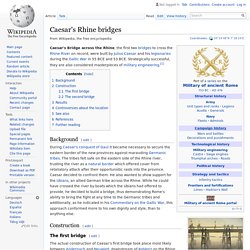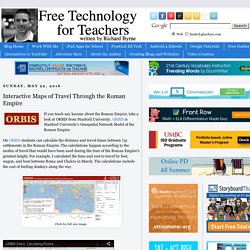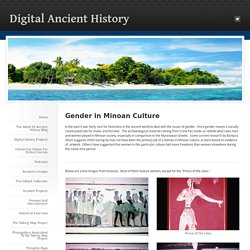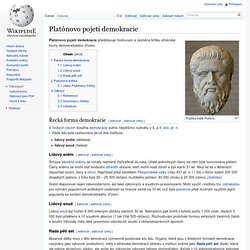

Julius Caesar Crossing the Rhine. Caesar's Rhine bridges. Italian version of Bridge Reconstruction of a Roman pile driver, used to build the Rhine bridge Caesar's Bridge across the Rhine, the first two bridges to cross the Rhine River on record, were built by Julius Caesar and his legionaries during the Gallic War in 55 BCE and 53 BCE.

Strategically successful, they are also considered masterpieces of military engineering.[1] Background[edit] During Caesar's conquest of Gaul it became necessary to secure the eastern border of the new provinces against marauding Germanic tribes. Construction[edit] Likely site of Rhine crossings The first bridge[edit] The actual construction of Caesar's first bridge took place most likely between Andernach and Neuwied, downstream of Koblenz on the Rhine River.
The construction of this bridge showed that Julius Caesar, and Rome, could go anywhere, if only for a few days. Interactive Maps of Travel Through the Roman Empire. If you teach any lessons about the Roman Empire, take a look at ORBIS from Stanford University.

ORBIS is Stanford University's Geospatial Network Model of the Roman Empire. On ORBIS students can calculate the distance and travel times between 751 settlements in the Roman Empire. The calculations happen according to the modes of travel that would have been used during the time of the Roman Empire's greatest height. For example, I calculated the time and cost to travel by foot, wagon, and boat between Roma and Chalcis in March. The calculations include the cost of feeding donkeys along the way. Applications for Education While you could certainly have students use Google Earth to map distances between settlements in the Roman Empire, ORBIS is a step above that because students can calculate travel times and distances according the modes of transportation that were available during the Roman Empire.
Gender in Minoan Culture - Digital Ancient History. Gender in Minoan Culture In the past it was fairly rare for historians in the ancient world to deal with the issues of gender.

Here gender means a socially constructed role for males and females. The archaeological material coming from Crete has made us rethink what roles men and women played in Minoan society, especially in comparison to the Mycenaean Greeks. Some current research by Barbara Olsen suggests child-rearing by may not have been the primary job of a woman in Minoan culture, at least based on evidence of artwork. Others have suggested that women in this particular culture had more freedoms than women elsewhere during this same time period. Below are some images from Knossos. September’s Infographics & Interactives Galore – Part Two. There are just so many good infographics and interactives out there that I’ve begun a new semi-regular feature called “Infographics & Interactives Galore.”

You can see others at A Collection Of “The Best…” Lists On Infographics and by searching “infographics” on this blog. I’ll still be publishing separate posts to individually highlight especially useful infographics and interactives, but you’ll find others in this regular feature. Here goes: 38 maps that explain Europe is from Vox. Dizzying optical illusions by Akiyoshi Kitaoka – in pictures is from The Guardian. Bitva u Cann (216 př. Kr.) Podklady pro diskusi: Proč se rozpadl Řím?
Athenska-demokracie-vypisky1.doc. Platónovo pojetí demokracie. Platónovo pojetí demokracie představuje hodnocení a zejména kritiku athénské formy demokratického zřízení.

Řecká forma demokracie[editovat | editovat zdroj] V řeckých obcích dosáhla demokracie svého největšího rozkvětu v 5. a 4. stol. př. n. l. Vláda lidu byla realizována skrze dvě instituce: lidový sněm (ekklesia)lidový soud (heliaia) Lidový sněm[editovat | editovat zdroj] Schůze lidového sněmu se konaly nejméně čtyřicetkrát do roka. Sněm disponoval nejen zákonodárnými, ale také výkonnými a soudními pravomocemi. Lidový soud[editovat | editovat zdroj] Lidový soud byl tvořen 6 000 volenými občany starších 30 let.
Rada pěti set[editovat | editovat zdroj] Absence dělby moci v této demokracii významně posilovala sílu lidu. Důležitým faktorem pro fungování demokracie v Athénách byl fakt, že se všichni občané mohli osobně znát a shromažďovat se na sněmech. Platónova kritika[editovat | editovat zdroj] Největší slabinou demokracie je to, že hlavní slovo a moc získává skupina demagogů - trubců [2] . Na tisk Athénská demokracie.rar. Neomezené stahování.

Ancient History Sourcebook: Main Page. The Internet Ancient History Sourcebook has expanded greatly since its creation, and now contains hundred of local files as well as links to source texts throughout the net. See Introduction for an explanation of the Sourcebook's goals. See the Help! Page for all the help on research I can offer. Although I am more than happy to receive notes if you have comments on this web site, I cannot answer specific research enquiries [and - for students - I cannot, or rather will not, do your homework.]
The Ancient History Sourcebook works as follows: This Main Index page [this page] shows all sections and sub sections. To access the sub-section pages , simply browse the sections below and select the highlighted (white text with blue background) section title on the left. In addition there are two navigation bars on the left of each page for every sub-section For materials added since July 1998 see the New Additions page.
Additional Study/Research Aids Introduction Paul Halsall , Compiler and Editor. Ancient Civilizations.